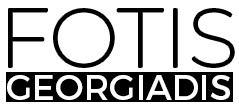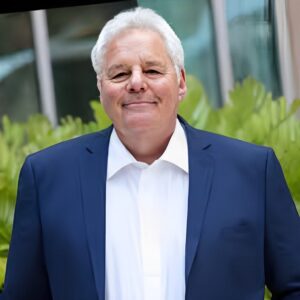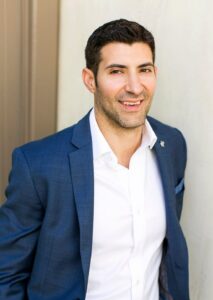Paul D Kreiter Of Kreiter Creatives Consulting On 5 Things You Need To Be A Highly Effective Public Speaker
An Interview With Fotis Georgiadis
Engage Your Audience: You’ll stand out as a memorable speaker if you give your audience a chance to engage throughout your presentation. Don’t wait until time is up to ask if there are any questions because your listeners might have wanted to ask a question early on but perhaps they didn’t feel the timing was right, or didn’t feel comfortable interrupting, or they may have forgotten their question altogether.
At some point in our lives, many of us will have to give a talk to a large group of people. What does it take to be a highly effective public speaker? How can you improve your public speaking skills? How can you overcome a fear of speaking in public? What does it take to give a very interesting and engaging public talk? In this interview series called “5 Things You Need To Be A Highly Effective Public Speaker” we are talking to successful and effective public speakers to share insights and stories from their experience. As a part of this series, we had the pleasure of interviewing Paul D. Kreiter.
Paul D. Kreiter, M.Ed. is a presentation coach and creative director from the Chicagoland area. Traditionally trained in the performing arts and education, he has spent the last decade working with the greatest speakers in the world, from Hollywood actors, iconic athletes, to innovative business executives, helping them understand how to communicate best with their audiences. Today, Paul has expanded his work to include company leaders and their teams, consulting them on how to create powerful, story-based presentations that fully engage virtual and in-person audiences.
Thank you so much for doing this with us! Our readers would love to get to know you a bit better. Can you tell us the story of how you grew up?
I grew up in Deerfield, IL, a north suburb of Chicago, with my parents and two sisters; I’m the middle child. I was raised in a household that valued education, the arts, music, sports, self-expression and the Jewish tradition. On any given evening, you would hear The Beatles, Led Zeppelin, REO Speedwagon blasting from my father’s stereo; he is an attorney who was in a fairly popular highschool band and continued to play the guitar. You’d see my older sister drawing murals on her bedroom walls; she would go on to study at the Art Institute Chicago. My mother could be found reading in a cozy nook; she filled our shelves with books and we pretty much had our very own Barns and Noble. You’d catch my younger sister scouring through softball footage and endlessly tossing a ball around; she ended up being a star college softball player and she still plays today. You’d find me playing video games, watching action/adventure movies and comedies (Indiana Jones, Kung Fu films, anything from Mel Brooks or National Lampoon) and running around outside with friends.
We always made time for family dinners to reflect on our weeks, but also never shied away from raucous debate on anything from homework assignments, to our social lives, to ethical issues. I have both fond and complicated memories.
Can you share a story with us about what brought you to this specific career path?
I mentioned fond and complicated memories; I think the latter in retrospect led on a path to where I am now in my career. While I described what would seem like a typical upbringing, our family suffered a great trauma early on. I was diagnosed with Acute Lymphocytic Leukemia at age three, a disease that complicated my biological, social, and learning development and stunted abundances of joy in my family. While I survived, I believe my family took a serious hit, and any physical and mental health issues that were manageable or dormant prominently rose to the surface. So, while I recovered and the music blasted, art was drawn, catch was played, and books were read, the thick and heavy film of childhood cancer and its heavy aftermaths have persisted.
They say when you survive cancer, you gain a perspective and wisdom well beyond your age. I believe this was true for me, and I took it upon myself to always find an opportunity to bring humor, joy, and levity to any relationship I was in or was developing. Over the years this manifested itself into my current charming personality, my love of stories and movies, but also my passion to tell stories and entertain. Through my entire childhood and young adulthood I acted, sang, danced, and performed improv; I jumped at any opportunity to engage an audience, with the goal of giving them a few minutes, hours of fun, artistic, worry-free escape from life’s complications. And I was good, I am still good, but also humble, and quite content knowing that my ability to engage people, develop and sustain relationships helps people.
I carried this philosophy, and love of storytelling and engaging audiences into the classroom as a teacher, into clinical and mentoring roles in social service, and currently in talent management and development and consulting. Every day I get to help people find their voice and craft creative experiences for audiences. I couldn’t be happier.
Can you tell us the most interesting story that happened to you since you began your career?
I have had the opportunity to meet some fascinating people. One of whom recently passed on, the late Archbishop Desmond Tutu. It’s exciting to be in the room with a distinguished world leader but also humbling to realize and remember that they are a person like everyone else. That has helped me a great deal in my career, helping others remember that we’re all people just trying to do our best.
Can you share a story about the funniest mistake you made when you were first starting? Can you tell us what lesson you learned from that?
Funny, maybe more embarrassing. For a virtual event, I was caught on hot mic freaking out that I couldn’t find my speaker’s headset and ear pods. The virtual audience got a nice show of my franticness! I learned a few things from this:
- Always be aware of your surroundings and equipment; know what’s on, what’s off, always triple check.
- Events are messy, managing talent is messy, but that is not an audiences’ business to know. This is why there is a thick black curtain at the theater; what’s going on behind the scenes is irrelevant to the audiences’ experience; they came for the show, not to learn how the sausage is made if you will.
None of us are able to achieve success without some help along the way. Is there a particular person who you are grateful towards who helped get you to where you are? Can you share a story about that?
My supervisor and mentor at the speaker’s bureau, Nancy Eisenstein, is this person for me. She took me on without me having the one-to-one experience the agency was looking for. She, herself, had a similar process, having come to the world of talent agencies after a tenure as a kindergarten teacher! She saw potential in me and great interest in my “journey” and had a feeling that it would be a great choice. She was right; the world of talent management, storytelling, and events felt so right to me and I owe so much to Nancy for helping me get a foot in the door.
You have been blessed with great success in a career path that can be challenging and intimidating. Do you have any words of advice for others who may want to embark on this career path, but seem daunted by the prospect of failure?
I have two bits of advice:
- Do not be fooled by the “Imposter Syndrome.” Own your expertise, commit to your professionalism, and remember that people are working with you/there to hear you speak because they see greatness in you. If they see it there is no reason you shouldn’t.
- It’s impossible to see your forest through your trees. Everyone should have a guide that has a birds eye view of your progress and process and can nudge you in the direction you’re unable to see for yourself. It’s the old adage, “You don’t know what you don’t know.” So, surround yourself with those who do know what you don’t and can move you into the know.
What drives you to get up everyday and give your talks? What is the main empowering message that you aim to share with the world?
Audiences deserve a performance, and I believe this is the duty of every presenter to deliver this kind of experience. Whether in front of large audiences in an auditorium, with small audiences in boardrooms or on video calls, embracing the role of PERFORMER is the core of my message.
You have such impressive work. What are some of the most interesting or exciting projects you are working on now? Where do you see yourself heading from here?
I just finished a presentation coaching project with a Veterinarian from Arizona. From her perspective, the profession is losing key talent, burnout is high, mental health crises, including issues around suicide, loom large, and the joy of the work is all but gone. She has experienced such realities in her own practice and personal life. She has been compelled to a call to action to help the profession “change the narrative” as she puts it, to bring back the passion and joy to Veterinary practice.
She came to me with abstract presentation concepts and through five 60–90 minutes sessions we were able to craft an emotional, data relevant, and dynamic 50 minute virtual presentation for an audience of 350 industry professionals. She effectively roused her audience with an impassioned keynote, and made such an impact she has been asked to speak again next month.
It is this sort of work, helping folks find their voice, craft their message, and structure their presentations that will move audiences, that sustains my purpose in my profession.
Can you please give us your favorite “Life Lesson Quote”? Can you share how that was relevant to you in your life?
There’s a Hopi tribe proverb that has inspired my work throughout my career. That saying is “Those who tell the stories rule the world.” I believe strongly that stories lay the foundation for good relationships, that good relationships lead to engaged interest, and engaged interest drives growth and profitability. The crux of this message has made me a creatively-minded leader, who is able to connect on a personal level with the stories that shape personal and organizational visions and successes.
Ok, thank you for all that. Here is the main question of our interview. What are your “5 Things You Need To Be A Highly Effective Public Speaker?” Please share a story or example for each.
- Speaking TONE and CADENCE: When we are excited about something we tend to want to talk about it loudly and quickly. While this may show genuine passion, it will cause audio dissonance with the audience. As it pertains to TONE, we want to choose precise moments when to be loud and soft during a presentation. Loud for moments of major significance; soft when coming to a transition moment or section. When it comes to CADENCE, Speaking slowly and deliberately allows for a smooth flow of the presentation, including planned moments for pause/transition.
- Presentation Structure: Typically, audiences want a performance, and I believe a speaker needs to present keeping this front of mind. To help speakers do this, I use a method called “Building The Sandwich with Artisan Storytelling,” which is designed to help speakers compartmentalize their content into apropos sections (intro, content, conclusion), while using creativity to move within sections. This structure is key for packaging an effective message, but also in creating a connection with the audience, as it takes them on a step by step journey that is both logical and exciting.
- Engage Your Audience: You’ll stand out as a memorable speaker if you give your audience a chance to engage throughout your presentation. Don’t wait until time is up to ask if there are any questions because your listeners might have wanted to ask a question early on but perhaps they didn’t feel the timing was right, or didn’t feel comfortable interrupting, or they may have forgotten their question altogether. This can be avoided by asking the audience to get involved at key points:
You can pose a question of significance to the audience right off the bat to spark discussion in your introductionOr you can disperse mini question and answer sessions as you conclude major content items.
Any of these tactics will signal to your audience that you’re likable, easy to converse with, and that you show genuine interest in them.
4. Lighting, Sound, and Visuals: Content and delivery are moot if you cannot be seen or heard. In-person events require a speaker to plan and rehearse with event audio-visual teams to ensure queues are in place from lighting transitions and screen displays for visual materials and microphones are working, and that backup plans are in place to troubleshoot.
For virtual events, a speaker is solely responsible for these items, and should check that:
Their presentation platform (zoom, teams, go to meeting, web x etc) is functioning appropriately.
The lighting in their presentation space is optimal; either they are recording in a well-lit room (not a basement, lots of windows/sun facing the front of the speaker’s face) or they have invested in a ring light, a stable light that surrounds their web camera.
Their camera is in working order and the picture is clear. External web cameras (not attached to their desktop or laptop computer) will provide the best picture quality/resolution (HD, 4k, etc).
That their internet connection is strong, ideally hardlined for the smoothest service.
Relevant to in-person events too, presentation visuals should be impactful but simple and help to create a positive experience for the audience: images should support the over message of the slide, for easy reading and comprehension PowerPoints should have minimal text, and reading slide text verbatim should be avoided.
5. Practice/Rehearse: Once everything has come together, you must practice and rehearse your presentation so that it feels natural when you arrive at the in-person or virtual stage. This can be done in a couple different ways:
Do your talk for someone (colleague, family member, or friend) and ask them for feedback.
Film yourself, watch your performance, and critique and tweak moments requiring change.
As you know, many people are terrified of speaking in public. Can you give some of your advice about how to overcome this fear?
Practice, practice, practice, with a person or group you trust. The fear of public speaking often comes from lack of experience; so the more you get the more you’ll find your comfort level.
You are a person of huge influence. If you could inspire a movement that would bring the most amount of good to the most amount of people, what would that be?
We never know where they are coming from or where they are going, nor do we have control of these realities. All we can control is how we spend the time we have with them, so make this fleeting moment impactful that leaves them and you changed for the better.
A speaker has a unique opportunity to make significant change. Even if just one person in the audience is better (has learned a practical skill for work, has been inspired to make a personal change, motivates someone to seek out an opportunity they had not considered, etc) for their message it’s worth it. Always remember that we have a finite amount of time with the random people we come in contact with.
Is there a person in the world whom you would love to have lunch with, and why? Maybe we can tag them and see what happens!
I have had the privilege of meeting some incredible people in my career, from celebrities, prominent athletes and authors, agents of social change. My first choice would be to spend time with someone who has passed on, Robin Williams. His comic and dramatic genius was a thing of wonder and I have been inspired by his expansive repertoire.
For those that are still with us, because I love to laugh and sing, I would relish the opportunity to have lunch with comedy legends and best friends Martin Short (who I have worked with before) Steve Martin, if only to sing “Blue Shadows” with them, one of the tender songs from the 1980’s comedy The Three Amigos!
Are you on social media? How can our readers follow you online?
My website is www.kreitercreatives.com.
Below are my social media links and handles:
- https://www.linkedin.com/in/pdkreiter/
- https://www.instagram.com/pdkartisanstorytelling/
- https://twitter.com/artisanstory
- https://www.tiktok.com/@paulatieburger
- https://www.facebook.com/kreitercreatives
This was so informative, thank you so much! We wish you continued success!
Paul D Kreiter Of Kreiter Creatives Consulting On 5 Things You Need To Be A Highly Effective Public… was originally published in Authority Magazine on Medium, where people are continuing the conversation by highlighting and responding to this story.



